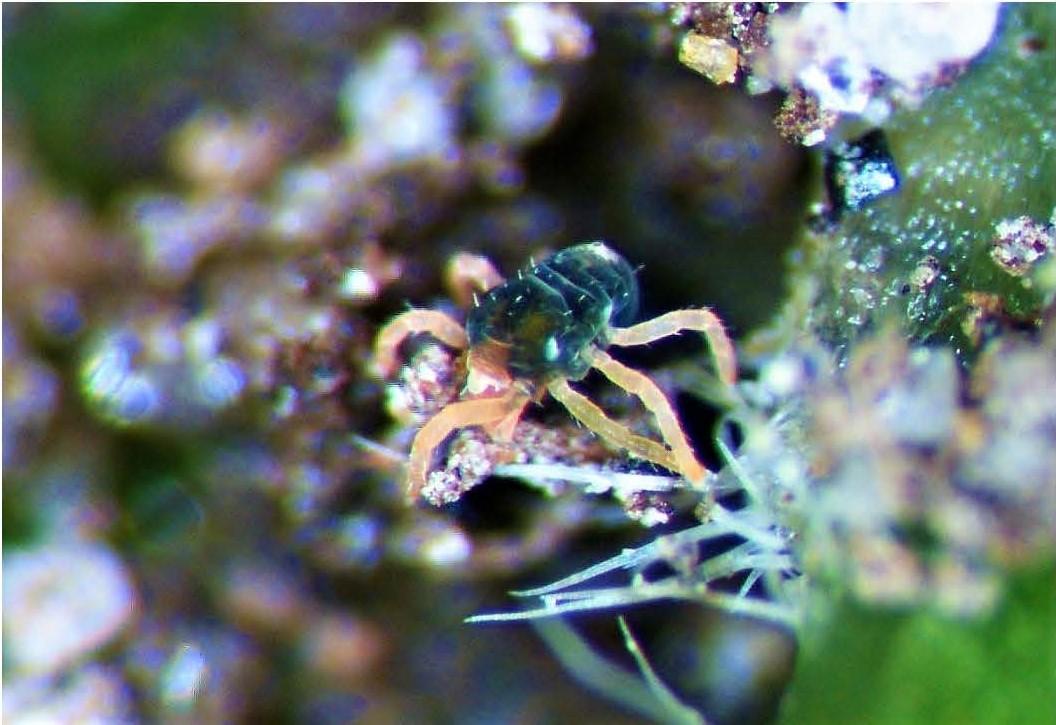Strange Mite Pest Found in High Tunnel Vegetables
Over the last three months a few early season high tunnel operations on the Eastern Shore were having problems with some of their seedlings and leaf crops. Crops like spinach would have ‘whitening’ and then browning and eventually dead margins of their leaves while seedlings would collapse. The problem was found to be ‘red legged winter mites’ Penthaleus dorsalis, which is a new pest in vegetables and herbs for us (fig 1). This mite was identified by Dr. Ron Ochoa, USDA, Beltsville. Because these mites are such new pests some of the information presented here is based on other closely related earth mite pest species.
Red legged winter mites thrive in what we would normally consider conditions too cold for an arthropod to cause problems. This mite is cold adjusted and cannot stand hot dry soil conditions and will die as summer heat approaches. Eggs are laid in late spring and they over-summer in the soil. These are stress resistant eggs (i.e., they can withstand drying and heat as well as synthetic chemical applications). In the fall they will begin to hatch, and mites will be active throughout the fall and winter inside a high tunnel with crops. Damage appears as 'silvering' or 'whitening' of the attacked foliage. Mites are most damaging to newly emerging crops, greatly reducing seedling survival and development.
Red legged winter mites are difficult to control even when using synthetic chemicals. Foliar sprays of Pyrethroids (check label for the crops that are labeled as this will vary greatly) or Pyrethrum + Neem or Beauveria bassiana + Pyrethrum will reduce feeding, but if mite populations are high it will be difficult to eliminate the damage. Applications should start as soon as damage is noticed before mites have a chance to build their population. Foliage should be thoroughly covered with spray material as should the base of plants.
Cultural controls involve using transplants instead of seeding the plants as the mites would do less damage to larger plants. Using high levels of heat such as clear plastic mulch to heat the soil and kill mites and if used in the summer kill even their eggs. Steam heat used to control nematodes and soil pathogens can be used to greatly reduce mite numbers before next fall’s planting. Many cultivations during the summer can significantly decrease the number of oversummering eggs that survive.
 English
English العربية
العربية Български
Български 简体中文
简体中文 繁體中文
繁體中文 Hrvatski
Hrvatski Čeština
Čeština Dansk
Dansk Nederlands
Nederlands Suomi
Suomi Français
Français Deutsch
Deutsch Ελληνικά
Ελληνικά हिन्दी
हिन्दी Italiano
Italiano 日本語
日本語 한국어
한국어 Norsk bokmål
Norsk bokmål Polski
Polski Português
Português Română
Română Русский
Русский Español
Español Svenska
Svenska Català
Català Filipino
Filipino עִבְרִית
עִבְרִית Bahasa Indonesia
Bahasa Indonesia Latviešu valoda
Latviešu valoda Lietuvių kalba
Lietuvių kalba Српски језик
Српски језик Slovenčina
Slovenčina Slovenščina
Slovenščina Українська
Українська Tiếng Việt
Tiếng Việt Shqip
Shqip Eesti
Eesti Galego
Galego Magyar
Magyar Maltese
Maltese ไทย
ไทย Türkçe
Türkçe فارسی
فارسی Afrikaans
Afrikaans Bahasa Melayu
Bahasa Melayu Kiswahili
Kiswahili Gaeilge
Gaeilge Cymraeg
Cymraeg Беларуская мова
Беларуская мова Íslenska
Íslenska Македонски јазик
Македонски јазик יידיש
יידיש Հայերեն
Հայերեն Azərbaycan dili
Azərbaycan dili Euskara
Euskara ქართული
ქართული Kreyol ayisyen
Kreyol ayisyen اردو
اردو বাংলা
বাংলা Bosanski
Bosanski Cebuano
Cebuano Esperanto
Esperanto ગુજરાતી
ગુજરાતી Harshen Hausa
Harshen Hausa Hmong
Hmong Igbo
Igbo Basa Jawa
Basa Jawa ಕನ್ನಡ
ಕನ್ನಡ ភាសាខ្មែរ
ភាសាខ្មែរ ພາສາລາວ
ພາສາລາວ Latin
Latin Te Reo Māori
Te Reo Māori मराठी
मराठी Монгол
Монгол नेपाली
नेपाली ਪੰਜਾਬੀ
ਪੰਜਾਬੀ Afsoomaali
Afsoomaali தமிழ்
தமிழ் తెలుగు
తెలుగు Yorùbá
Yorùbá Zulu
Zulu ဗမာစာ
ဗမာစာ Chichewa
Chichewa Қазақ тілі
Қазақ тілі Malagasy
Malagasy മലയാളം
മലയാളം සිංහල
සිංහල Sesotho
Sesotho Basa Sunda
Basa Sunda Тоҷикӣ
Тоҷикӣ O‘zbekcha
O‘zbekcha አማርኛ
አማርኛ Corsu
Corsu Ōlelo Hawaiʻi
Ōlelo Hawaiʻi كوردی
كوردی Кыргызча
Кыргызча Lëtzebuergesch
Lëtzebuergesch پښتو
پښتو Samoan
Samoan Gàidhlig
Gàidhlig Shona
Shona سنڌي
سنڌي Frysk
Frysk isiXhosa
isiXhosa